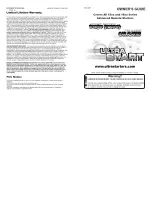
Installation
28
Generic System Diagram
gives the general layout of a typical remote system. The common cable path will
run out from the termination panel at the base station site to the farthest remote in the
system. This remote must be set to a 600
impedance in order to properly terminate the
transmission line. Any other remotes in the system which are bridged across the line closer
to the termination panel must be set to a high impedance in order to keep them from
loading the line. The setting of an individual remotes impedance is done with jumpers that
are set at the time it is interfaced to the transmission line.
Figure 6: Typical Remote System Layout
Setup Mode Switch Functions
While the bulk of the programming necessary to define the functions of a remote is done
using a PC and the off-line programming software, there are still some items involved in
setting up a unit that are taken care of from the front panel. The instructions given here
cover how to enter and exit the Setup mode and the special functions assigned to the keys
while in that mode.
The Setup mode involves the top two rows of programmable keys on the front of the
deskset, and the middle key in the column of three to the right of the DTMF keypad. The
top row will be referred to as function keys 1-4 (left to right), the second row as function
keys 5-8, and the key above the transmit button is function key 9, as shown in
To enter the setup mode, press function keys 1 and 8 simultaneously. The LCD display
should say “Setup Mode” on the top line. Once in setup mode, the functions of the nine
keys are as described in
.
Base
Station
Remote
Termination
Panel
Remote
#1
Hi-Z
Termination
Remote
#2
Hi-Z
Termination
Remote
#3
600
Termination
Wire line, or possible leased line
















































